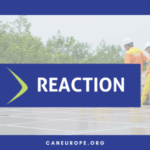Tomorrow’s State of the European Union address is a perfect opportunity for European Commission President Jean-Claude Juncker to reveal the progress so far in the development of the new EU long-term climate strategy. Stating his support for reducing emissions to net zero at the latest by 2050 and keeping temperature rise to 1.5C would be an appropriate and timely response to the unprecedented heat waves and forest fires that we have witnessed over the summer and the multiple calls from non-state actors, Member States and the European Parliament to scale up the EU’s climate action.
The extreme heatwaves and wildfires wreaking havoc in Europe and around the globe this summer could become the norm in the near future if we continue emitting greenhouse gases at the current level. An infographic published by CAN Europe today shows that climate-related extreme weather events already cost Europe dearly: EUR14bn only in 2017. It also shows that the future costs depend very much on how fast we cut carbon emissions and will be significantly reduced if we keep temperature rise to 1.5C.
Ahead of President Juncker’s State of the Union speech, Wendel Trio, Director of Climate Action Network (CAN) Europe said:
“The Juncker Commission still has work to do in order to translate the objectives of the Paris Agreement into a concrete strategy for the EU. After this year’s disastrous summer, it is the right moment to provide clarity on the Commission’s plans to fully implement the Paris Agreement and scale up the EU’s climate action to better protect European citizens. To rise to the challenge, President Juncker should state his support for the 1.5°C temperature limit and the full decarbonisation by 2050 at the latest.”
In June EU governments, business, local authorities and NGOs urged the European Commission to ensure that its new long term climate strategy, to be presented in November, contains both a pathway to reduce greenhouse gas emissions towards net zero in the EU by 2050, and a pathway to limit temperature rise to 1.5°C, which would need to be even more ambitious.
The Commission has also been urged to align the 2030 target for greenhouse gas emission reductions with these more ambitious long term emission reduction trajectories. Some EU Member States, such as the Netherlands and Sweden, have recently called for the 2030 climate target to be raised to at least 55%.
The new EU long term strategy must compare costs and benefits of action with total cost of inaction for specific temperature thresholds – outlined in the CAN Europe’s infographic published today.
Contacts:
Wendel Trio, CAN Europe Director, wendel@caneurope.org, +32 473 170 887
Ania Drazkiewicz, CAN Europe Head of Communications, ania@caneurope.org, +32 494 525 738
Notes:
Climate Action Network (CAN) Europe is Europe’s leading NGO coalition fighting dangerous climate change. With over 150 member organisations from 35 European countries, representing over 1.700 NGOs and more than 40 million citizens, CAN Europe promotes sustainable climate, energy and development policies throughout Europe.


